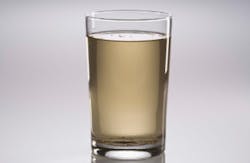BIRMINGHAM — In Water Technology’s Contaminant of the Month featured in the November issue, Technical Editor Dr. Joseph Cotruvo explores what turbidity is, where it comes from, potential health risks, how it is measured, available water treatment as well as regulations and guidelines.
In the article, Cotruvo provides the following water treatment options for turbidity:
- Filtration technologies are the standard methods for reducing turbidity.
- Conventional coagulation, flocculation and granular filtration as well as direct filtration are effective.
- Membrane technologies, including microfiltration, ultrafiltration, nanofiltration as well as reverse osmosis, are effective.
Various regulations and guidelines pertaining to turbidity are also discussed in the article:
- In the U.S., the most important turbidity requirements apply to performance management of required surface water filtration treatment processes.
- The traditional turbidity MCL is 1 ntu that applied to surface waters at the plant and drove introduction of filtration intended to reduce the risk of microbial contamination and improve disinfection efficacy.
- The 1989 surface water filtration rule was driven by removal of Giardia protozoa.
- The 2006 Long Term Surface Water Treatment (LT2) requirement is aimed at reducing Cryptosporidium from source waters.
- The 1989 rule also reduced Cryptosporidium but the 2006 rule was more stringent by reducing the MCL to 0.3 ntu 95 percent of the time never to exceed 1 ntu, and requiring compliance at each operating filter.
- The WHO Guidelines for Drinking-water Quality are somewhat ambiguous. They discuss the aesthetics and health concerns of turbidity and recommend 1 ntu for larger systems and < 5 for smaller systems. This has led to some confusion because turbidity < 1 ntu in surface supplies is important for health protection — entirely distinct from aesthetics.
You can find November’s Contaminant of the Month on turbidity here.
About the Author
Sign up for our eNewsletters
Get the latest news and updates
